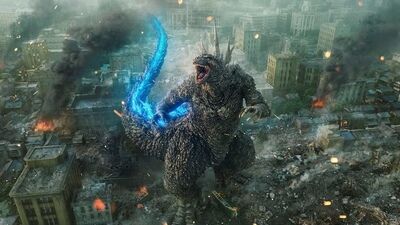Set in 1946, “Godzilla Minus One” follows a spiritually depleted group of ex-military men as they rally to vanquish everyone’s favorite kaiju antihero. Here, Godzilla’s presence is a given, as it probably should be after dozens of movies and spinoff projects. If traumatized survivors like disgraced kamikaze pilot Koichi Shikishima (Ryunosuke Kamiki) can’t stop Godzilla, he will destroy Ginza and then stomp all over Tokyo.
Koichi is motivated by survivor’s guilt. In an establishing scene on Odo Island, Koichi takes aim at Godzilla, but can’t bring himself to shoot. As a result, several fellow army men die, leaving Koichi to bury their bodies. Reviving Koichi’s ultimately patriotic mojo takes priority, since that sort of nationalistic passion is apparently essential to fighting Godzilla. At the same time, Koichi’s loved ones are still very dead, so now he has to take care of other survivors, most of whom have also lost their loved ones, their homes, and their wills to fight. That last part is crucial, but overcoming spiritual decline is also a big part of Koichi and therefore Big G’s story in “Godzilla Minus One.”
“I would like to try to live again,” Koichi says with square-jawed sincerity. His intense need to prove himself is paralleled, but never matched by fellow cast-offs like Kenji Noda (Hidetaka Yoshioka), a bookish ex-weapons engineer, and Sosaku Tachibana (Munetaka Aoki), an ex-Navy mechanic. These guys only hint at their inner demons; they often literally wear their trauma on their sleeves since the ash and grime of post-war recovery has already overtaken them. Some female protagonists, like Koichi’s selfless sweetie Noriko Oishi (Minami Hamabe) and his newly-orphaned adopted daughter Akiko (Sae Nagatani), also give him more reasons to fight, though their agency and personalities are even more limited than Koichi’s male co-stars.
Godzilla’s also in “Godzilla Minus One,” by the way, and he’s treated with apparent reverence. “Godzilla Minus One” is a well-calibrated popcorn movie, and you can hear it in the way that its creators play up fan favorite devices and associations. It’s an event when he roars or deploys his fire breath for the first time in this movie. Godzilla fans will probably also feel appropriately flattered by the strategic use of a few song cues from Akira Ifukube’s now iconic “Gojira” score.
Ifukube’s music is worked in seamlessly without sounding much like new music by “Godzilla Minus One” composer Naoki Sato, who lays down a droning orchestral wall of sound that his string section flits across like a surfer riding a towering and perpetually cresting wave. It’s one of the most rousing and nerve-wracking original scores in a recent Godzilla movie. Tactically deployed silences and mood-setting background noises also punctuate and goose the already overwhelming on-screen action.

